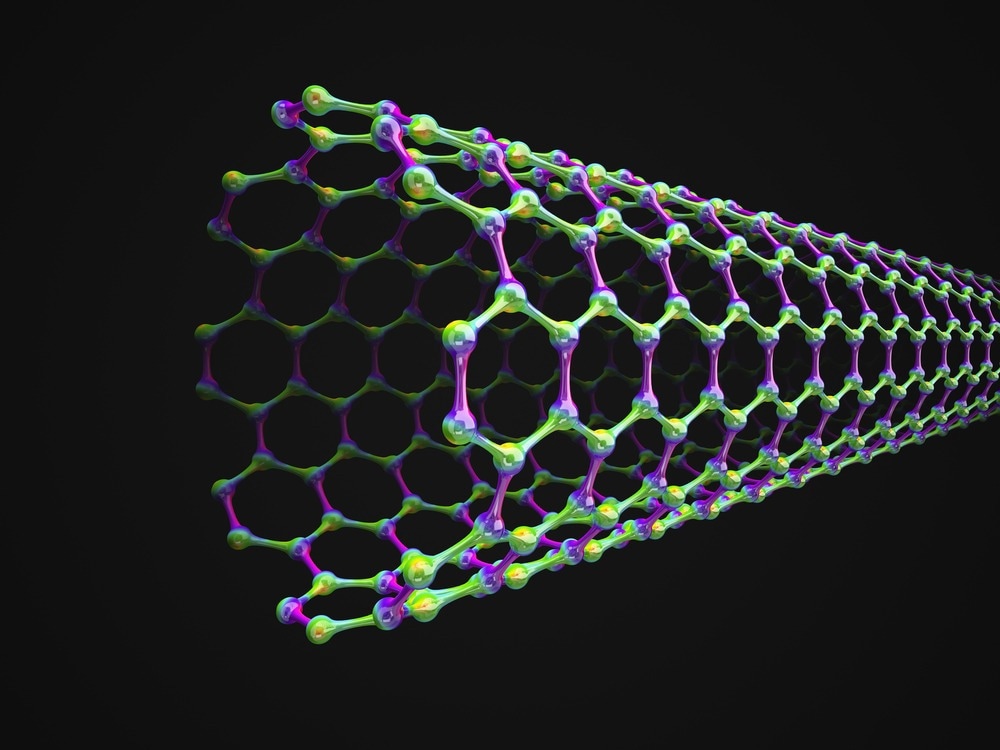Carbon-based nanomaterials such as carbon nanotubes (CNTs), fullerenes, and graphene receive a great deal of attention today due to their unique physical properties. A new study explores the potential of hybrid nanostructures and introduces a new porous graphene CNT hybrid structure with remarkable thermal and mechanical properties.

Image Credit: Orange Deer studio/Shutterstock.com
The study shows how the remarkable characteristics of novel graphene CNT hybrid structures could be modified by slightly changing the inherent geometric arrangement of CNTs and graphene, plus various filler agents.
The ability to accurately control thermal conductivity and mechanical strength in the graphene CNT hybrid structures make them a potentially suitable candidate for various application areas, especially in advanced aerospace manufacturing where weight and strength are critical.
Carbon Nanostructures: CNTs, Graphene, Fullerenes
Carbon nanostructures and hybrids of multiple carbon nanostructures have been examined recently as potential candidates for numerous sensing, photovoltaic, antibacterial, energy storage, fuel cell, and environmental improvement applications.
The most prominent carbon-based nanostructures in the research appear to be CNTs, graphene, and fullerene. These structures exhibit unique thermal, mechanical, electronic, and biological properties due to their extremely small size.
Structures that measure in the sub-nanometer range behave according to the peculiar laws of quantum physics, and so they can be used to exploit nonintuitive phenomena such as quantum tunneling, quantum superposition, and quantum entanglement.
CNTs are tubes made out of carbon and that measure only a few nanometers across in diameter. CNTs display notable electrical conductivity, and some are semiconductor materials.
CNTs also have great tensile strength and thermal conductivity due to their nanostructure, and the strength of covalent bonds formed between carbon atoms.
CNTs are potentially valuable materials for electronics, optics, and composite materials, where they may replace carbon fibers in the next few years. Nanotechnology and materials science also use CNTs in research.
Graphene is a carbon allotrope that is shaped into a single layer of carbon atoms arranged in a two-dimensional lattice structure composed of hexagonal shapes. Graphene was first isolated in a series of groundbreaking experiments by University of Manchester, UK, scientists Andrew Geim and Konstantin Novoselov in 2004, earning them the Nobel Prize for Physics in 2010.
In the few decades since then, graphene has become a useful nanomaterial with exceptionally high tensile strength, transparency, and electrical conductivity leading to numerous and varied applications in electronics, sensing, and other advanced technologies.
A fullerene is another carbon allotrope that has been known for some time. Its molecule consists of carbon atoms that are connected by single and double bonds to form a mesh, which can be closed or partially closed. The mesh is fused with rings of five, six, or seven atoms.
Fullerene molecules can be hollow spheres, ellipsoids, tubes, or a number of other shapes and sizes. Graphene could be considered an extreme member of the fullerene family, although it is considered a member of its own material class.
Hybrid Nanostructures
As well as a great deal of research invested into understanding and characterizing these carbon nanostructures in isolation, scientists are also exploring the properties of hybrid nanostructures that combine two or more nanostructure elements into one material.
For example, foam materials have adjustable properties that make them suitable for practical applications like sandwich structure design, biocompatibility design, and high strength and low weight structure design.
Carbon-based nanofoams have been utilized in medicine as well, examining bone injuries as well as acting as the base for replacement bone tissue.
Carbon-based cellular structures are produced both with chemical vapor deposition (CVD) and solution processing. Spark plasma sintering (SPS) methods are also implemented for using graphene for biological and medical applications.
As a result, scientists have been looking at ways to make three-dimensional carbon foams structurally stable. Research suggests that stable junctions between different types of structures (CNTs, fullerene, and graphene) need to be formed for this material to be stable enough for extensive application.
New Research on Hybrid Nanostructures
New research from mechanical engineers at Turkey’s Istanbul Technical University introduces a new hybrid nanostructure formed through chemical bonding.
The porous graphene CNT structures were made by organizing graphene around CNTs in nanoribbons. The different geometrical arrangement of graphene nanoribbon layers around CNTs (square, hexagon, and diamond patterns) led to different physical properties being observed in the material, suggesting that this geometric rearrangement could be used to fine-tune the new structure.
The study was published in the journal Physica E: Low-dimensional Systems and Nanostructures in 2022.
Researchers found that the structures with fullerenes inserted, for example, exhibited significant compressive stability and strength without sacrificing tensile strength. The geometric arrangement of carbon nanostructures also had a significant effect on their thermal properties.
Researchers said that these new hybrid nanostructures present important advantages, especially for the aerospace industry. Nanoarchitectures with these hybrid structures may also be utilized in hydrogen storage and nanoelectronics.
References and Further Reading
Belkin, A., A. Hubler, and A. Bezryadin (2015). Self-Assembled Wiggling Nano-Structures and the Principle of Maximum Entropy Production. Scientific Reports. doi.org/10.1038/srep08323
Degirmenci, U., and M. Kirca (2022). Carbon-based nano lattice hybrid structures: Mechanical and thermal properties. Physica E: Low-dimensional Systems and Nanostructures. doi.org/10.1016/j.physe.2022.115392
Geim, A.K. (2009). Graphene: Status and Prospects. Science. /doi.org/10.1126/science.1158877
Geim, A.K., and K.S. Novoselov (2007). The rise of graphene. Nature Materials. doi.org/10.1038/nmat1849
Monthioux, M., and V.L. Kuznetsov (2006). Who should be given the credit for the discovery of carbon nanotubes? Carbon. doi.org/10.1016/j.carbon.2006.03.019
Disclaimer: The views expressed here are those of the author expressed in their private capacity and do not necessarily represent the views of AZoM.com Limited T/A AZoNetwork the owner and operator of this website. This disclaimer forms part of the Terms and conditions of use of this website.